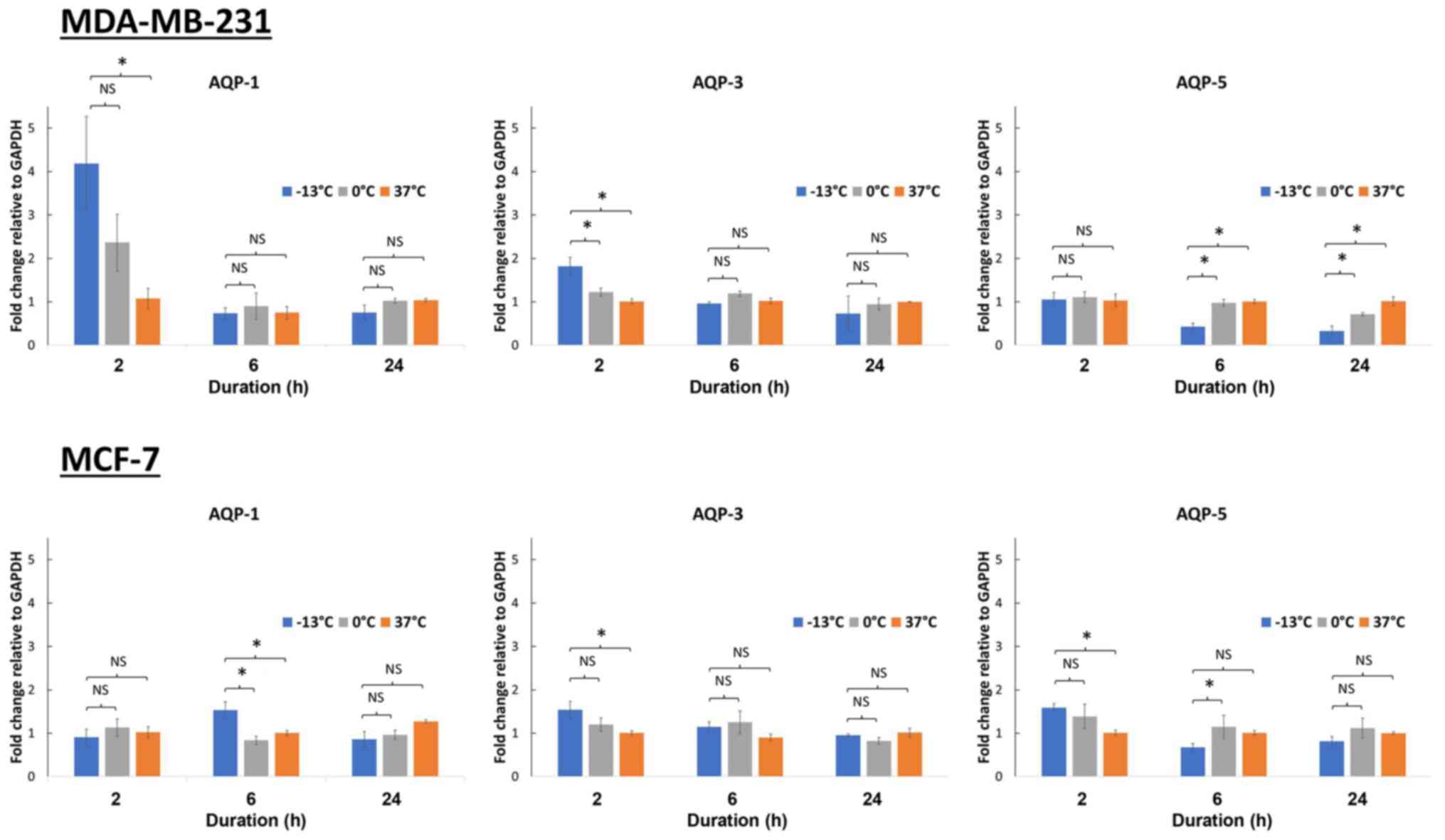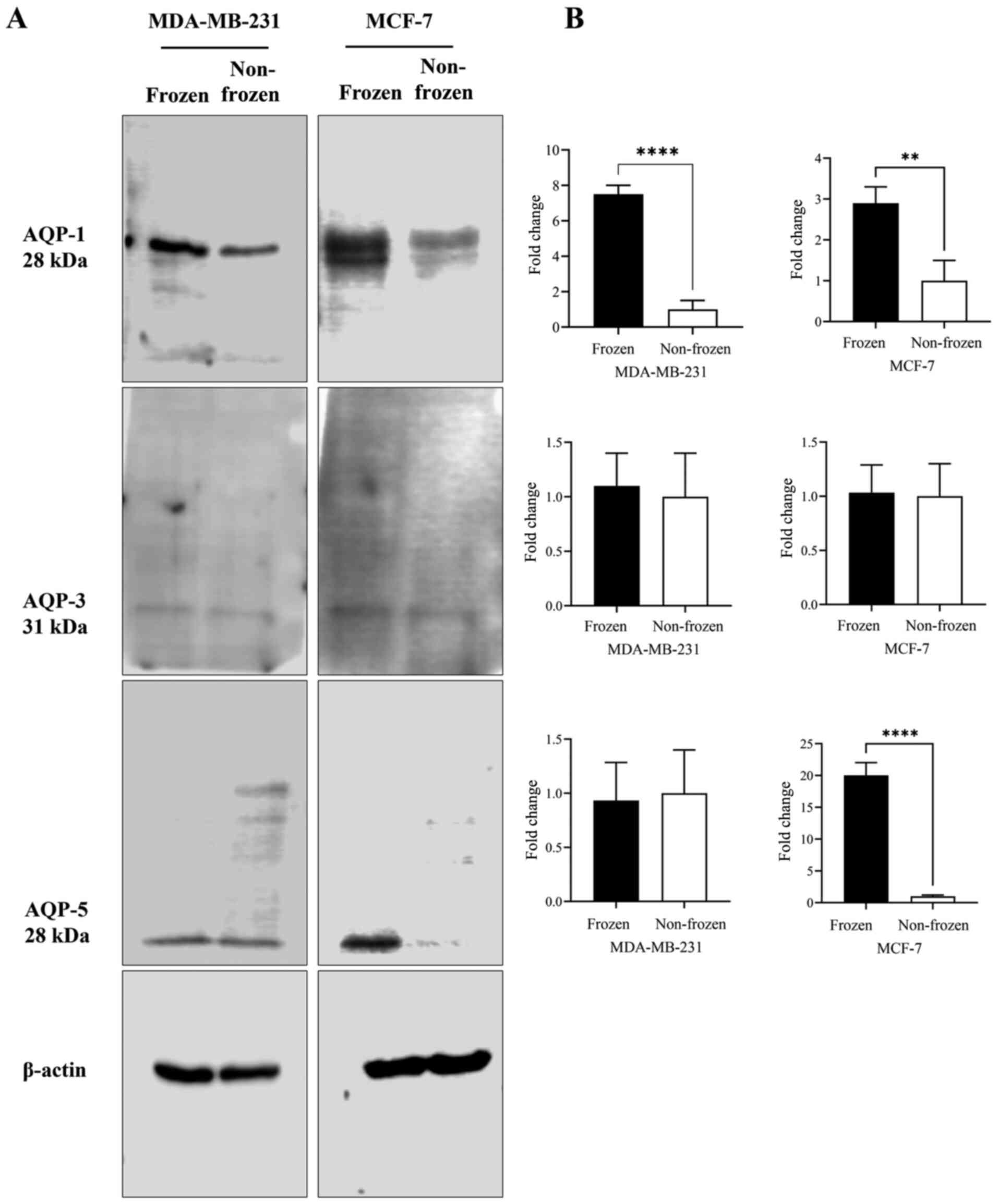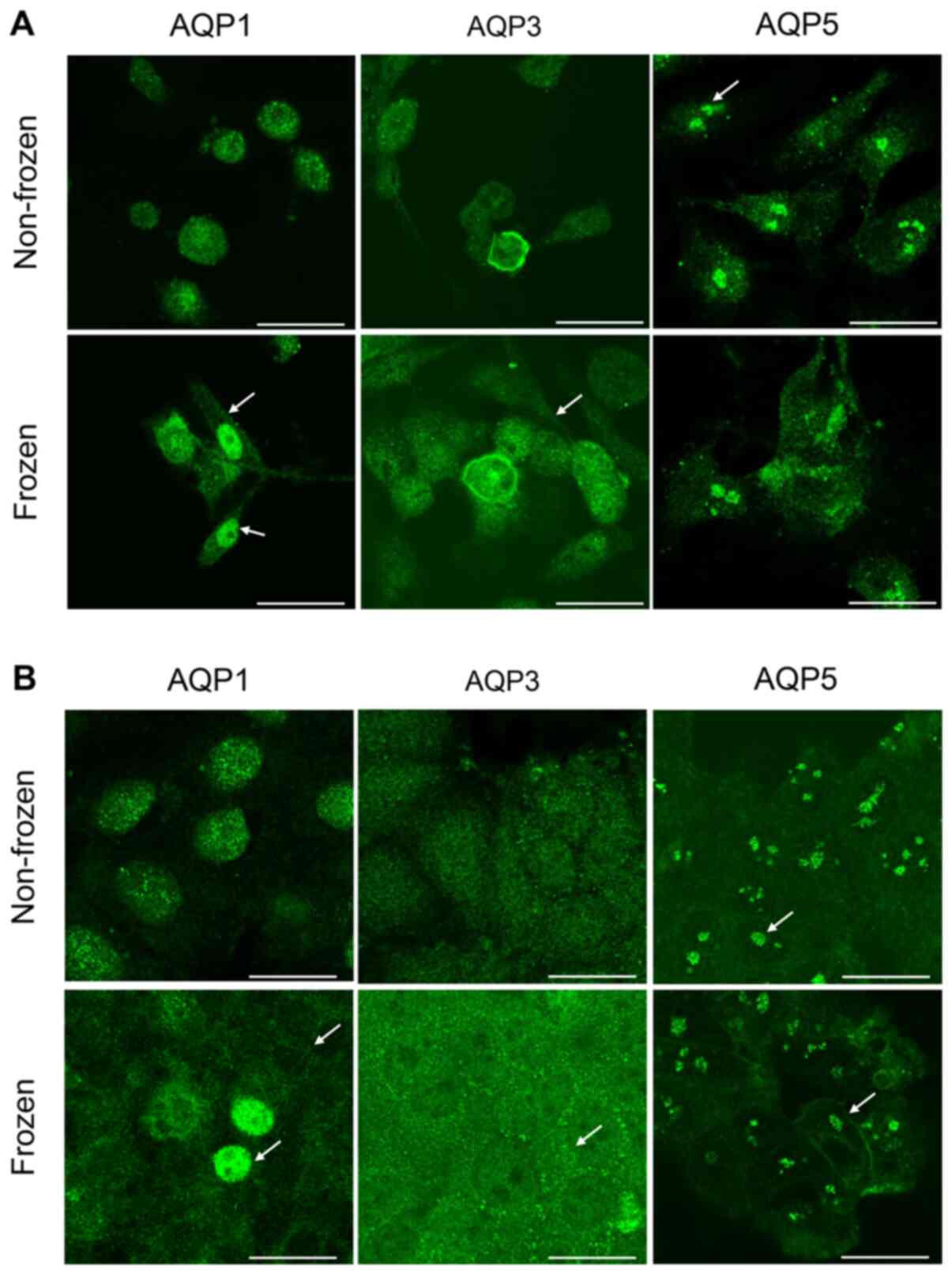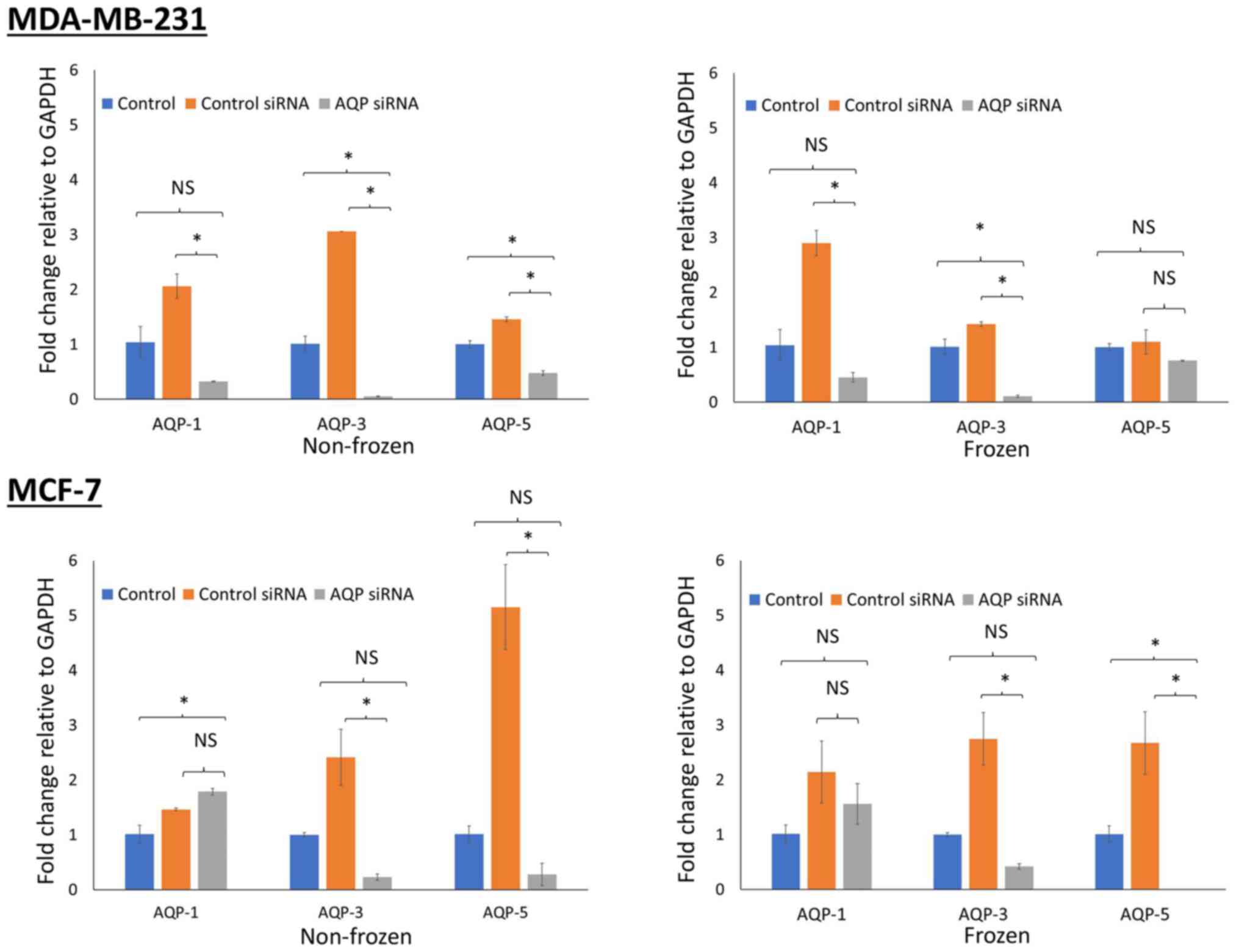|
1
|
Bray F, Ferlay J, Soerjomataram I, Siegel
RL, Torre LA and Jemal A: Global cancer statistics 2018: GLOBOCAN
estimates of incidence and mortality worldwide for 36 cancers in
185 countries. CA Cancer J Clin. 68:394–424. 2018. View Article : Google Scholar : PubMed/NCBI
|
|
2
|
Global Burden of Disease Cancer
Collaboration, ; Fitzmaurice C, Allen C, Barber RM, Barregard L,
Bhutta ZA, Brenner H, Dicker DJ, Chimed-Orchir O, Dandona R, et al:
Global, regional, and national cancer incidence, mortality, years
of life lost, years lived with disability, and disability-adjusted
life-years for 32 cancer groups, 1990 to 2015: A systematic
analysis for the global burden of disease study. JAMA Oncol.
3:524–548. 2017. View Article : Google Scholar : PubMed/NCBI
|
|
3
|
PDQ Adult Treatment Editorial Board, .
Breast cancer treatment (Adult) (PDQ®): Patient version.
PDQ Cancer Information Summaries. National Cancer Institute (USA);
Bethesda, MD: 2002
|
|
4
|
Sharma GN, Dave R, Sanadya J, Sharma P and
Sharma KK: Various types and management of breast cancer: An
overview. J Adv Pharm Technol Res. 1:109–126. 2010.PubMed/NCBI
|
|
5
|
Pusceddu C, Melis L, Ballicu N, Meloni P,
Sanna V, Porcu A and Fancellu A: Cryoablation of primary breast
cancer in patients with metastatic disease: Considerations arising
from a single-centre data analysis. Biomed Res Int.
2017:38390122017. View Article : Google Scholar : PubMed/NCBI
|
|
6
|
Erinjeri JP and Clark TW: Cryoablation:
Mechanism of action and devices. J Vasc Interv Radiol. 21 (Suppl
8):S187–S191. 2010. View Article : Google Scholar
|
|
7
|
Pusceddu C, Paliogiannis P, Nigri G and
Fancellu A: Cryoablation in the management of breast cancer:
Evidence to date. Breast Cancer (Dove Med Press). 11:283–292.
2019.PubMed/NCBI
|
|
8
|
Beji H, Pilleul F, Picard R, Tredan O,
Bouhamama A, Peix M, Mavrovi E and Mastier C: Percutaneous
cryoablation of breast tumours in patients with stable metastatic
breast cancer: Safety, feasibility and efficacy. Br J Radiol.
91:201705002018. View Article : Google Scholar : PubMed/NCBI
|
|
9
|
Holmes DR: Breast cancer care during a
pandemic: An opportune time for cryoablation? Breast Cancer Res
Treat. 182:515–521. 2020. View Article : Google Scholar : PubMed/NCBI
|
|
10
|
Mahnken AH, König AM and Figiel JH:
Current technique and application of percutaneous cryotherapy.
Rofo. 190:836–846. 2018.(In English, German). View Article : Google Scholar : PubMed/NCBI
|
|
11
|
Niu L, Mu F, Zhang C, Li Y, Liu W, Jiang
F, Li L, Liu C, Zeng J, Yao F, et al: Cryotherapy protocols for
metastatic breast cancer after failure of radical surgery.
Cryobiology. 67:17–22. 2013. View Article : Google Scholar : PubMed/NCBI
|
|
12
|
Baust JG, Gage AA, Bjerklund Johansen TE
and Baust JM: Mechanisms of cryoablation: Clinical consequences on
malignant tumors. Cryobiology. 68:1–11. 2014. View Article : Google Scholar : PubMed/NCBI
|
|
13
|
Aarts BM, Klompenhouwer EG, Rice SL, Imani
F, Baetens T, Bex A, Horenblas S, Kok M, Haanen JBAG, Beets-Tan RGH
and Gómez FM: Cryoablation and immunotherapy: An overview of
evidence on its synergy. Insights Imaging. 10:532019. View Article : Google Scholar : PubMed/NCBI
|
|
14
|
Gage AA and Baust J: Mechanisms of tissue
injury in cryosurgery. Cryobiology. 37:171–186. 1998. View Article : Google Scholar : PubMed/NCBI
|
|
15
|
Hoffmann NE and Bischof JC: The
cryobiology of cryosurgical injury. Urology. 60 (Suppl 1):S40–S49.
2002. View Article : Google Scholar
|
|
16
|
Santucci KL, Snyder KK, Baust JM, Van
Buskirk RG, Mouraviev V, Polascik TJ, Gage AA and Baust JG: Use of
1,25α dihydroxyvitamin D3 as a cryosensitizing agent in a murine
prostate cancer model. Prostate Cancer Prostatic Dis. 14:97–104.
2011. View Article : Google Scholar : PubMed/NCBI
|
|
17
|
Baust JG, Snyder KK, Santucci KL,
Robilotto AT, Van Buskirk RG and Baust JM: Cryoablation: Physical
and molecular basis with putative immunological consequences. Int J
Hyperthermia. 36 (Suppl 1):S10–S16. 2019. View Article : Google Scholar
|
|
18
|
Clarke DM, Baust JM, Van Buskirk RG and
Baust JG: Chemo-cryo combination therapy: An adjunctive model for
the treatment of prostate cancer. Cryobiology. 42:274–285. 2001.
View Article : Google Scholar : PubMed/NCBI
|
|
19
|
Clarke DM, Baust JM, Van Buskirk RG and
Baust JG: Addition of anticancer agents enhances freezing-induced
prostate cancer cell death: Implications of mitochondrial
involvement. Cryobiology. 49:45–61. 2004. View Article : Google Scholar : PubMed/NCBI
|
|
20
|
Le Pivert P, Haddad RS, Aller A, Titus K,
Doulat J, Renard M and Morrison DR: Ultrasound guided combined
cryoablation and microencapsulated 5-Fluorouracil inhibits growth
of human prostate tumors in xenogenic mouse model assessed by
luminescence imaging. Technol Cancer Res Treat. 3:135–142. 2004.
View Article : Google Scholar : PubMed/NCBI
|
|
21
|
Baust JM, Klossner DP, Robilotto A,
Vanbuskirk RG, Gage AA, Mouraviev V, Polascik TJ and Baust JG:
Vitamin D(3) cryosensitization increases prostate cancer
susceptibility to cryoablation via mitochondrial-mediated apoptosis
and necrosis. BJU Int. 109:949–958. 2012. View Article : Google Scholar : PubMed/NCBI
|
|
22
|
Ismail M, Bokaee S, Morgan R, Davies J,
Harrington KJ and Pandha H: Inhibition of the aquaporin 3 water
channel increases the sensitivity of prostate cancer cells to
cryotherapy. Br J Cancer. 100:1889–1895. 2009. View Article : Google Scholar : PubMed/NCBI
|
|
23
|
Khajah MA and Luqmani YA: Role of
aquaporins in breast cancer progression and metastasis. Tumor Met.
59–83. 2016.
|
|
24
|
Wang L, Zhang Y, Wu X and Yu G:
Aquaporins: New targets for cancer therapy. Technol Cancer Res
Treat. 15:821–828. 2016. View Article : Google Scholar : PubMed/NCBI
|
|
25
|
Hagedorn M, Lance SL, Fonseca DM,
Kleinhans FW, Artimov D, Fleischer R, Hoque AT, Hamilton MB and
Pukazhenthi BS: Altering fish embryos with aquaporin-3: An
essential step toward successful cryopreservation. Biol Reprod.
67:961–966. 2002. View Article : Google Scholar : PubMed/NCBI
|
|
26
|
Edashige K, Yamaji Y, Kleinhans FW and
Kasai M: Artificial expression of aquaporin-3 improves the survival
of mouse oocytes after cryopreservation. Biol Reprod. 68:87–94.
2003. View Article : Google Scholar : PubMed/NCBI
|
|
27
|
Tanghe A, Van Dijck P, Colavizza D and
Thevelein JM: Aquaporin-mediated improvement of freeze tolerance of
Saccharomyces cerevisiae is restricted to rapid freezing
conditions. Appl Environ Microbiol. 70:3377–3382. 2004. View Article : Google Scholar : PubMed/NCBI
|
|
28
|
Tanghe A, Van Dijck P and Thevelein JM:
Why do microorganisms have aquaporins? Trends Microbiol. 14:78–85.
2006. View Article : Google Scholar : PubMed/NCBI
|
|
29
|
Tietz PS, McNiven MA, Splinter PL, Huang
BQ and Larusso NF: Cytoskeletal and motor proteins facilitate
trafficking of AQP1-containing vesicles in cholangiocytes. Biol
Cell. 98:43–52. 2006. View Article : Google Scholar : PubMed/NCBI
|
|
30
|
Riethmüller C, Oberleithner H, Wilhelmi M,
Franz J, Schlatter E, Klokkers J and Edemir B: Translocation of
aquaporin-containing vesicles to the plasma membrane is facilitated
by actomyosin relaxation. Biophys J. 94:671–678. 2008. View Article : Google Scholar
|
|
31
|
Conner AC, Bill RM and Conner MT: An
emerging consensus on aquaporin translocation as a regulatory
mechanism. Mol Membr Biol. 30:1–12. 2013. View Article : Google Scholar : PubMed/NCBI
|
|
32
|
Cohen E: Roles of aquaporins in
osmoregulation, desiccation and cold hardiness in insects. Entomol
Ornithol Herpetol. S1:1–17. 2012.
|
|
33
|
Kato Y, Miyauchi T, Abe Y, Kojić D, Tanaka
M, Chikazawa N, Nakatake Y, Ko SB, Kobayashi D, Hazama A, et al:
Unprecedented cell-selection using ultra-quick freezing combined
with aquaporin expression. PLoS One. 9:e876442014. View Article : Google Scholar : PubMed/NCBI
|
|
34
|
Wang J, Feng L, Zhu Z, Zheng M, Wang D,
Chen Z and Sun H: Aquaporins as diagnostic and therapeutic targets
in cancer: How far we are? J Transl Med. 13:962015. View Article : Google Scholar : PubMed/NCBI
|
|
35
|
Satooka H and Hara-Chikuma M: Aquaporin-3
controls breast cancer cell migration by regulating hydrogen
peroxide transport and its downstream cell signaling. Mol Cell
Biol. 36:1206–1218. 2016. View Article : Google Scholar : PubMed/NCBI
|
|
36
|
Zhu Z, Jiao L, Li T, Wang H, Wei W and
Qian H: Expression of AQP3 and AQP5 as a prognostic marker in
triple-negative breast cancer. Oncol Lett. 16:2661–2667.
2018.PubMed/NCBI
|
|
37
|
Otterbach F, Callies R, Adamzik M, Kimmig
R, Siffert W, Schmid KW and Bankfalvi A: Aquaporin 1 (AQP1)
expression is a novel characteristic feature of a particularly
aggressive subgroup of basal-like breast carcinomas. Breast Cancer
Res Treat. 120:67–76. 2010. View Article : Google Scholar : PubMed/NCBI
|
|
38
|
Qin F, Zhang H, Shao Y, Liu X, Yang L,
Huang Y, Fu L, Gu F and Ma Y: Expression of aquaporin1, a water
channel protein, in cytoplasm is negatively correlated with
prognosis of breast cancer patients. Oncotarget. 7:8143–8154. 2016.
View Article : Google Scholar : PubMed/NCBI
|
|
39
|
Nielsen TO, Hsu FD, Jensen K, Cheang M,
Karaca G, Hu Z, Hernandez-Boussard T, Livasy C, Cowan D, Dressler
L, et al: Immunohistochemical and clinical characterization of the
basal-like subtype of invasive breast carcinoma. Clin Cancer Res.
10:5367–5374. 2004. View Article : Google Scholar : PubMed/NCBI
|
|
40
|
Hugh J, Hanson J, Cheang MC, Nielsen TO,
Perou CM, Dumontet C, Reed J, Krajewska M, Treilleux I, Rupin M, et
al: Breast cancer subtypes and response to docetaxel in
node-positive breast cancer: Use of an immunohistochemical
definition in the BCIRG 001 trial. J Clin Oncol. 27:1168–1176.
2009. View Article : Google Scholar : PubMed/NCBI
|
|
41
|
Blows FM, Driver KE, Schmidt MK, Broeks A,
van Leeuwen FE, Wesseling J, Cheang MC, Gelmon K, Nielsen TO,
Blomqvist C, et al: Subtyping of breast cancer by
immunohistochemistry to investigate a relationship between subtype
and short and long term survival: A collaborative analysis of data
for 10,159 cases from 12 studies. PLoS Med. 7:e10002792010.
View Article : Google Scholar : PubMed/NCBI
|
|
42
|
Carey LA, Dees EC, Sawyer L, Gatti L,
Moore DT, Collichio F, Ollila DW, Sartor CI, Graham ML and Perou
CM: The triple negative paradox: Primary tumor chemosensitivity of
breast cancer subtypes. Clin Cancer Res. 13:2329–2334. 2007.
View Article : Google Scholar : PubMed/NCBI
|
|
43
|
Dent R, Trudeau M, Pritchard KI, Hanna WM,
Kahn HK, Sawka CA, Lickley LA, Rawlinson E, Sun P and Narod SA:
Triple-negative breast cancer: Clinical features and patterns of
recurrence. Clin Cancer Res. 13:4429–4434. 2007. View Article : Google Scholar : PubMed/NCBI
|
|
44
|
Liedtke C, Mazouni C, Hess KR, André F,
Tordai A, Mejia JA, Symmans WF, Gonzalez-Angulo AM, Hennessy B,
Green M, et al: Response to neoadjuvant therapy and long-term
survival in patients with triple-negative breast cancer. J Clin
Oncol. 26:1275–1281. 2008. View Article : Google Scholar : PubMed/NCBI
|
|
45
|
Li X, Yang J, Peng L, Sahin AA, Huo L,
Ward KC, O'Regan R, Torres MA and Meisel JL: Triple-negative breast
cancer has worse overall survival and cause-specific survival than
non-triple-negative breast cancer. Breast Cancer Res Treat.
161:279–287. 2017. View Article : Google Scholar : PubMed/NCBI
|
|
46
|
Cailleau R, Olive M and Cruciger QV:
Long-term human breast carcinoma cell lines of metastatic origin:
Preliminary characterization. In vitro. 14:911–915. 1978.
View Article : Google Scholar : PubMed/NCBI
|
|
47
|
Chavez KJ, Garimella SV and Lipkowitz S:
Triple negative breast cancer cell lines: One tool in the search
for better treatment of triple negative breast cancer. Breast Dis.
32:35–48. 2010. View Article : Google Scholar : PubMed/NCBI
|
|
48
|
Sweeney EE, McDaniel RE, Maximov PY, Fan P
and Jordan VC: Models and mechanisms of acquired antihormone
resistance in breast cancer: Significant clinical progress despite
limitations. Horm Mol Biol Clin Investig. 9:143–163.
2012.PubMed/NCBI
|
|
49
|
Jung HJ, Park JY, Jeon HS and Kwon TH:
Aquaporin-5: A marker protein for proliferation and migration of
human breast cancer cells. PLoS One. 6:e284922011. View Article : Google Scholar : PubMed/NCBI
|
|
50
|
Ahmad AE, Khajah MA, Khushaish S and
Luqmani YA: Aquaporin expression in breast cancer and their
involvement in bleb formation, cell motility and invasion in
endocrine resistant variant cells. Int J Oncol. 56:1014–1024.
2020.PubMed/NCBI
|
|
51
|
Wei M, Yu H, Cai C, Gao R, Liu X and Zhu
H: MiR-3194-3p inhibits breast cancer progression by targeting
Aquaporin1. Front Oncol. 10:15132020. View Article : Google Scholar : PubMed/NCBI
|
|
52
|
Zhu F, Chen L, Zhou Y, An J, Wu Z, Hu J,
Ma Z and Cao F: Cellular-mesenchymal to epithelial transition
factor upregulates aquaporin 3 expression in human breast cancer
cells. Res Sq. 2020.
|
|
53
|
Snyder KK, Van Buskirk RG, Baust JG and
Baust JM: Breast cancer cryoablation: Assessment of the impact of
fundamental procedural variables in an in vitro human breast cancer
model. Breast Cancer (Auckl). 14:11782234209723632020.PubMed/NCBI
|
|
54
|
Livak KJ and Schmittgen TD: Analysis of
relative gene expression data using real-time quantitative PCR and
the 2(-Delta Delta C(T)) method. Methods. 25:402–408. 2001.
View Article : Google Scholar : PubMed/NCBI
|
|
55
|
Skehan P, Storeng R, Scudiero D, Monks A,
McMahon J, Vistica D, Warren JT, Bokesch H, Kenney S and Boyd MR:
New colorimetric cytotoxicity assay for anticancer-drug screening.
J Natl Cancer Inst. 82:1107–1112. 1990. View Article : Google Scholar : PubMed/NCBI
|
|
56
|
Littrup PJ, Jallad B, Chandiwala-Mody P,
D'Agostini M, Adam BA and Bouwman D: Cryotherapy for breast cancer:
A feasibility study without excision. J Vasc Interv Radiol.
20:1329–1341. 2009. View Article : Google Scholar : PubMed/NCBI
|
|
57
|
Cazzato RL, de Lara CT, Buy X, Ferron S,
Hurtevent G, Fournier M, Debled M and Palussière J: Single-centre
experience with percutaneous cryoablation of breast cancer in 23
consecutive non-surgical patients. Cardiovasc Intervent Radiol.
38:1237–1243. 2015. View Article : Google Scholar : PubMed/NCBI
|
|
58
|
Fujita Y, Yamamoto N, Sobue K, Inagaki M,
Ito H, Arima H, Morishima T, Takeuchi A, Tsuda T, Katsuya H and
Asai K: Effect of mild hypothermia on the expression of aquaporin
family in cultured rat astrocytes under hypoxic condition. Neurosci
Res. 47:437–444. 2003. View Article : Google Scholar : PubMed/NCBI
|
|
59
|
Salman MM, Kitchen P, Woodroofe MN, Brown
JE, Bill RM, Conner AC and Conner MT: Hypothermia increases
aquaporin 4 (AQP4) plasma membrane abundance in human primary
cortical astrocytes via a calcium/transient receptor potential
vanilloid 4 (TRPV4)- and calmodulin-mediated mechanism. Eur J
Neurosci. 46:2542–2547. 2017. View Article : Google Scholar : PubMed/NCBI
|
|
60
|
Papadopoulos MC and Saadoun S: Key roles
of aquaporins in tumor biology. Biochim Biophys Acta.
1848:2576–2583. 2015. View Article : Google Scholar : PubMed/NCBI
|
|
61
|
Dajani S, Saripalli A and Sharma-Walia N:
Water transport proteins-aquaporins (AQPs) in cancer biology.
Oncotarget. 9:36392–36405. 2018. View Article : Google Scholar : PubMed/NCBI
|
|
62
|
Abir-Awan M, Kitchen P, Salman MM, Conner
MT, Conner AC and Bill RM: Inhibitors of mammalian aquaporin water
channels. Int J Mol Sci. 20:15892019. View Article : Google Scholar : PubMed/NCBI
|
|
63
|
Prevette LE, Mullen DG and Holl MM:
Polycation-induced cell membrane permeability does not enhance
cellular uptake or expression efficiency of delivered DNA. Mol
Pharm. 7:870–883. 2010. View Article : Google Scholar : PubMed/NCBI
|
|
64
|
Tomita Y, Dorward H, Yool AJ, Smith E,
Townsend AR, Price TJ and Hardingham JE: Role of Aquaporin 1
signalling in cancer development and progression. Int J Mol Sci.
18:2992017. View Article : Google Scholar : PubMed/NCBI
|
|
65
|
Taurin S, Allen KM, Scandlyn MJ and
Rosengren RJ: Raloxifene reduces triple-negative breast cancer
tumor growth and decreases EGFR expression. Int J Oncol.
43:785–792. 2013. View Article : Google Scholar : PubMed/NCBI
|
|
66
|
Chong W, Zhang H, Guo Z, Yang L, Shao Y,
Liu X, Zhao Y, Wang Z, Zhang M, Guo C, et al: Aquaporin 1 promotes
sensitivity of anthracycline chemotherapy in breast cancer by
inhibiting β-catenin degradation to enhance TopoIIα activity. Cell
Death Differ. 28:382–400. 2021. View Article : Google Scholar : PubMed/NCBI
|
|
67
|
Han Z and Patil RV: Protein Kinase
A-dependent phosphorylation of aquaporin-1. Biochem Biophys Res
Commun. 273:328–332. 2000. View Article : Google Scholar : PubMed/NCBI
|



















